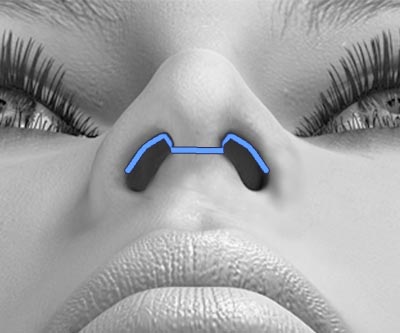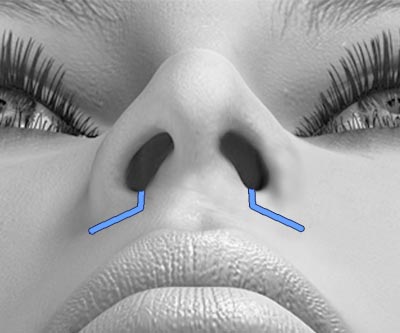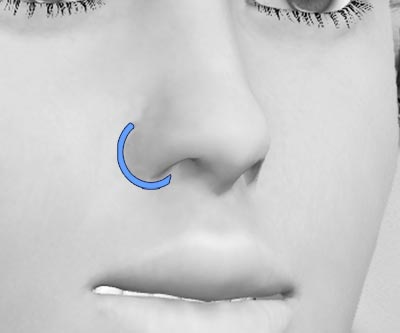The ethnic rhinoplasty is an upgraded complexity level above the open structure rhinoplasty noses, aggravated due to some very specific ethnical factors featuring every particular racial group, like tiny nasal bones with almost non-existent dorsum, overprominent polly beak deformity or supratip prominence, minimal nasal and caudal septum length, filmy, weak and incompetent medial and lateral cruras of the alar cartilages, severely inverted or concave lateral cruras, enormously bulbous, absolutely non-supported and not defined at all tip with large fat deposits, extreme hypertrophy of alar flare and nostrils, massive requirements of additional structure supply with large, thick and multiple cartilage grafting often involving the rib as donor site, fascia grafting and others; those patients with mixed blood may present an unique combination of ethnicity challenges belonging to more than one of those groups.
Most commonly considered ethnic rhinoplasties due to their complexity, consequence of either pure or mixed blood genetic background, are Afroamerican, Afrocaribbean, any black or mulatto, Chinese, Korean, Japanese, Thai, Philippine, Malaysian, any Asian, Moroccan, Northern African, Middle Eastern, Turkish, any Arab, Pakistani, Indian, Jewish, Lebanese, Mediterranean, Southern, Central And Northern European, Finish, any Nordic, Russian, any Slavic, Latino, Andine, South American Indian, Hispanic, any Latin American noses and others; as a rule of thumb any structure rhinoplasty candidate with massive requirements of surgical skills, full grafting sets, complex techniques, long operating room time and escalated costs due to its ethnicity.
Some of the most common techniques applied in the open structure rhinoplasty are cartilage grafting harvested from nasal septum, ear's concha bowl or rib cartilage, harvesting of deep or superficial temporalis fascia grafting, tip domal plication or suturing, plasties of tip domes, alternate incomplete domal transections, tip graft, Sheen's graft, shield graft, columellar strut or tutor graft, lateral cruras tutor or batten graft, lateral cruras exchange or crossed location, lateral cruras replacement graft, lateral cruras caudal extension graft, tongue in groove fixation of medial cruras, lateral and medial cruras plication or suturing, lateral and medial cruras length trimming for shortening or grafting for lengthening, lateral and medial cruras repositioning, medial cruras footplates plication or suturing, nostrils rim graft, middle vault spreader or spacer grafts, paramedian reduction of dorsal plateau or rhombus, septal lengthening graft, septal caudal extension grafts, dorsal onlay graft, supratip graft, radix graft, dorsal fascia graft and other custom grafting, alar base reduction, nostrils reduction and other custom procedures.
Typical scenarios where an open structure rhinoplasty is indicated are the short nose, long nose, poorly defined tip, short or underprojected tip, overprojected tip or Pinocchio's nose, bifid or cleft tip and columella, bulbous tip, boxy tip, asymmetric tip, buckled tip, inverted or concave lateral cruras, over rotated or upturned tip, piggy nose, severely hooked or droopy tip, hanging columella or columellar exposure show, alar rim retraction, septal mucosa exposure show, sunken supratip, polly beak deformity or supratip prominence, tension nose, pinched middle vault, hourglass dorsum, rhomboid dorsum, broad dorsum, humpless dorsum, dorsal ridges, low sunken dorsum or saddle nose deformity, low radix, high humpless dorsum, high radix, prominent alar flare, large nostrils, filmy and transparent nasal skin, pinched or incompetent nasal valve, severe asymmetries and others; as a rule of thumb any augmentation, lengthening, aggressively downsizing, aggressively shortening, significantly reshaping, congenital, atypical and complex rhinoplasty belongs to this modality, as well as those cases the patient is seeking high grade of refinement and perfecting.
This nose job is normally carried out by means of the open rhinoplasty or external approach at the columella and also inside the nostrils, alar base and others, with optimal quality and well concealed scars, through which structure of the nose is modified as well as resized, grafting applied, plications or sutures performed and other maneuvers executed; additional well hidden scars behind the ear, within the hairy temple scalp, underneath the breast and others might be necessary as donor sites of any grafted material.
Patients warning: only highly experienced surgeons who have underwent optimal training and have performed already a large number of closed and open approach structure and non structure rhinoplasties should execute high end rhinoplasty cases, should they feel capable and comfortable with the challenge.
READ LESS ABOUT ETHNIC RHINOPLASTY


 READ MORE ABOUT SURGERY SHIELD
READ MORE ABOUT SURGERY SHIELD





 READ MORE ABOUT BENEFITS OF THE COLLABORATIVE MODEL
READ MORE ABOUT BENEFITS OF THE COLLABORATIVE MODEL